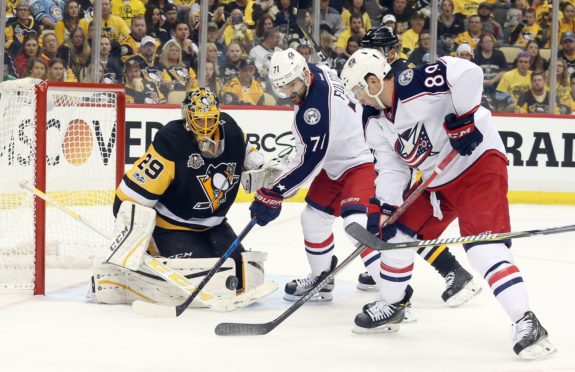The second round of the 2017 Stanley Cup Playoffs is in full swing, and the best teams in the National Hockey League are rising to the top. Well, sort of.

See, the league redesigned its playoff format in 2013-14 to coincide with its divisional realignment. Basically, the top three teams in each division make the postseason, and then the two next-best teams in each conference take the two wild card spots. The division winners face the wild card teams (the division winner with the best record in the regular season faces the worst wild card team), and the winner of that first-round series goes on to face the winner of the series pitting the second and third-place teams in said division against each other.
Got that?
Good Intentions
The idea was to ensure two rounds of divisional play, pitting heated rivals – who have, ideally, developed a healthy hatred after playing four or five times during the regular season – against each other, thereby drawing huge interest and massive ratings. This season, we came oh so very close to having both Toronto-Ottawa AND Calgary-Edmonton in the first round (shout-outs to Columbus and Anaheim, respectively, for ruining our fun). And right now, we are currently enjoying what is already another classic,nostalgia-inducing Pittsburgh-Washington barn-burner.
So, in theory, this format makes sense. The potential for two exciting rounds of rivalry combined with the minimal travel of divisional matchups (shut up, Florida teams)? Has the NHL finally done something right?
Devaluing Own Product
Does the NHL really need artificially generated excitement for the first round of the playoffs? With 16 teams playing at once, three or four games on in one night, and teams at full strength and energy, not to mention everyone’s brackets still being intact, the excitement level for the first round – and even the second – is already high enough.

Take the Pittsburgh-Washington series, unquestionably the most anticipated matchup of the year. Can the Capitals finally overcome the Penguins, giving the team, not to mention Alex Ovechkin, a shot at the finals? Will Pittsburgh’s piecemeal defense hold up and give them a chance to repeat as Cup champions? The storylines are endless.
However, because it takes place in the second round – and could, theoretically, have taken place in the first, eyes – and therefore ratings – are diverted away from this seminal matchup by other series, including two with Canadian teams involved. Think how much better would it be, for fans (higher stakes, less competing series) and the NHL (higher ratings, better marketing of marquee matchups), if this were the Eastern Conference Final.
Punishing Good Teams
On another Pittsburgh-Washington note, this playoff format often punishes the teams that were best during the regular season. Of Washington, Pittsburgh and Columbus, who finished first, second and third, respectively, in the Eastern Conference standings, two of the three had, by design, no possible shot at the conference final. Isn’t the whole idea of the playoffs to have the best teams competing at the highest levels?
The Crossover
Meanwhile, the New York Rangers – fourth in the above-mentioned Metropolitan Division and fifth in the conference, took the first wild card spot, meaning they faced the Montreal Canadiens – the lesser of the two Eastern Conference division leaders – in the first round. As such, their path to the conference final goes through the Atlantic Division. Thus, while Washington, Pittsburgh and Columbus are beating each other up, the Rangers, theoretically anyway, could steamroll over a much-weaker Atlantic Division for their shot at making the Cup final.

Division Championships
The Rangers are currently pitted against the Ottawa Senators for the Atlantic Division championship. But wait, didn’t the Montreal Canadiens already claim the Atlantic Division crown on the basis of their regular season prowess? Do the winners of divisions in the playoffs get banners, too? And how are you going to tell me that the New York Rangers are the Atlantic Division champions? With this format, theoretically, the Nashville Predators could win the Pacific Division, and the Vancouver Canucks the Central. Insanity.
Past Mistakes
This playoff format pays worryingly little heed to the lessons of history. Take the 1980s, for example. The Edmonton Oilers, Calgary Flames and Winnipeg Jets were unquestionably the class of the Clarence Campbell Conference. They also all played in the same division – the Smythe. These three teams would constantly beat up on each other – with the Oilers usually coming out on top, while their conference-mates in the pathetic Norris Division would vomit up some unfortunate representative to get demolished in the conference final.
As a result, hockey fans rarely got to see any sort of success from two of the era’s best teams – the Flames (though they did make the Stanley Cup Final twice, winning in 1989) and the Jets, as they both kept running into one of the best teams of all time – the Oilers (if not each other). Check out the history of Flames seasons, along with that of the Jets, and you’ll see what I mean.
Meanwhile, the 83-point 1984-85 Chicago Blackhawks came out of the Norris in to face the Oilers in the conference finals, while the 96-point Jets (who lost to Edmonton) and 94-point Calgary (who lost to Winnipeg) were eliminated early on.
Or how about 1986-87, when the 78-point Detroit Red Wings faced the 106-point Oilers, the latter having defeated the 88-point Jets, who had defeated the 95-point Flames.
Carry on like this, and the NHL might well rob another generation of seeing the best teams of the era playing in truly meaningful games, if not competing for championships.
What Was Wrong With the Old One?
In an ideal world, NHL teams would be seeded one through 16, with the first-ranked team playing the sixteenth, the second-ranked playing the fifteenth, and so on. That said, travel considerations scuttle this idea, as you can’t really have Vancouver and Florida flying across the continent every couple days and expect to see good hockey. Dividing teams by conference, therefore, is eminently reasonable.
Which begs the question: what was wrong with the old format? What was wrong with division winners taking the conference’s top slots and letting the rest of the teams battle it out for positioning? More room to move would guarantee more competitive hockey in the regular season down the stretch, and truly great teams will be rewarded for their work during the grueling, 82-game season with favourable playoff positioning.
And yet, time and time again, the NHL does the exact opposite of what logic dictates it should. I suppose we should be used to it by now.